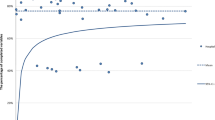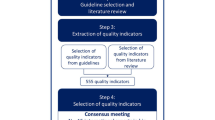Abstract
Summary
This study was carried out to analyze the evolution of the quality indicators in the Spanish National Hip Fracture Registry, after disseminating a series of recommendations based on available clinical practice guidelines to the participating hospitals. Six of the seven proposed quality indicators showed a significant improvement.
Purpose
The Spanish National Hip Fracture Registry (RNFC) arises from the need to know the process and improve the quality of care. Our goal was to analyze the changes in the RNFC’s quality indicators after an intervention based on disseminating specific recommendations among the participating hospitals, following available clinical practice guidelines.
Methods
Study comparing before and after performing an intervention in hospitals participating in the RNFC. Data from the hospitals that registered cases in 2017, and that kept registering cases in 2019. Seven quality indicators were chosen, and a standard to be achieved for each indicator was proposed. The intervention consisted in the dissemination of 25 recommendations with practical measures to improve each quality indicator, based on available clinical practice guidelines, by drafting and publishing a scientific paper and sending it via email and printed cards. Fulfilment of each quality indicator was measured after carrying out the intervention.
Results
Forty-three hospitals registered 2674 cases between January and May, 2017, and 8037 during 2019. The quality indicators chosen and the degree of compliance were (all with p<0.05): (1) surgery ≤48 h increased from 38.9 to 45.8%; (2) patients mobilised on the first postoperative day increased from 58.9 to 70.3%; (3) patients with anti-osteoporotic medication at discharge increased from 34.5 to 49.8%; (4) patients with calcium supplements at discharge increased from 48.7 to 62.8%; (5) patients with vitamin D supplements at discharge increased from 71.5 to 84.7%; (6) patients developing a grade >2 pressure ulcer during admission decreased from 6.5 to 5.0%; (7) patients able to move on their own at 1 month fell from 58.8 to 56.4%. More than 48% of hospitals improved the proposed indicators.
Conclusion
Establishing quality indicators and standards and intervening through the dissemination of specific recommendations to improve these indicators achieved an improvement in hospital performance results on a national level.

Similar content being viewed by others
References
Sáez López P, Madruga Galán F, Rubio Caballero JA (2007) Detección de problemas en pacientes geriátricos con fractura de cadera. Importancia de la colaboración entre traumatólogo y geriatra. Rev Ortop y Traumatol 51:144–151. https://doi.org/10.1016/S0482-5985(07)75541-4
González Montalvo JI, Alarcón Alarcón T, Pallardo Rodil B et al (2008) Ortogeriatría en pacientes agudos (II). Aspectos clínicos. Rev Esp Geriatr Gerontol 43:316–329. https://doi.org/10.1016/S0211-139X(08)73574-1
Leibson CL, Tosteson ANA, Gabriel SE et al (2002) Mortality, disability, and nursing home use for persons with and without hip fracture: a population-based study. J Am Geriatr Soc 50:1644–1650. https://doi.org/10.1046/j.1532-5415.2002.50455.x
Abrahamsen B, Van Staa T, Ariely R et al (2009) Excess mortality following hip fracture: a systematic epidemiological review. Osteoporos Int 20:1633–1650. https://doi.org/10.1007/s00198-009-0920-3
Katsoulis M, Benetou V, Karapetyan T et al (2017) Excess mortality after hip fracture in elderly persons from Europe and the USA: the CHANCES project. J Intern Med 281:300–310. https://doi.org/10.1111/joim.12586
Dyer SM, Crotty M, Fairhall N et al (2016) A critical review of the long-term disability outcomes following hip fracture. BMC Geriatr 16:158. https://doi.org/10.1186/s12877-016-0332-0
Svedbom A, Hernlund E, Ivergård M et al (2013) Osteoporosis in the European Union: a compendium of country-specific reports. Arch Osteoporos 136. https://doi.org/10.1007/s11657-013-0137-0
Cancio JM, Vela E, Santaeugènia S et al (2019) Long-term impact of hip fracture on the use of healthcare resources: a population-based study. J Am Med Dir Assoc 20:456–461. https://doi.org/10.1016/j.jamda.2018.08.005
Azagra R, López-Expósito F, Martin-Sánchez JC et al (2014) Changing trends in the epidemiology of hip fracture in Spain. Osteoporos Int 25:1267–1274. https://doi.org/10.1007/s00198-013-2586-0
Alarcón Alarcón T, González-Montalvo JI (2004) Fractura osteoporótica de cadera. Factores predictivos de recuperación funcional a corto y largo plazo. An Med Interna 21:87–96. https://doi.org/10.4321/s0212-71992004000200010
(2007) The Care of Patients with Fragility Fracture. The Blue Book. British Orthopaedic Association and British Geriatric Society, London
Patel NK, Sarraf KM, Joseph S et al (2013) Implementing the National Hip Fracture Database: An audit of care. Injury 44:1934–1939. https://doi.org/10.1016/j.injury.2013.04.012
Neuburger J, Currie C, Wakeman R et al (2015) The impact of a national clinician-led audit initiative on care and mortality after hip fracture in England. Med Care 53:686–691. https://doi.org/10.1097/MLR.0000000000000383
Sáez-López P, Ojeda-Thies C, Alarcón T et al (2019) Spanish National Hip Fracture Registry (RNFC): first-year results and comparison with other registries and prospective multi-centric studies from Spain. Rev Esp Salud Publica 93:e201910072
Sáez-López P, González-Montalvo JI, Ojeda-Thies C et al (2018) Spanish National Hip Fracture Registry (SNHFR): a description of its objectives, methodology and implementation. Rev Esp Geriatr Gerontol 53:188–195. https://doi.org/10.1016/j.regg.2017.12.001
Ojeda-Thies C, Sáez-López P, Currie CT et al (2019) Spanish National Hip Fracture Registry (RNFC): analysis of its first annual report and international comparison with other established registries. Osteoporos Int 30:1243–1254. https://doi.org/10.1007/s00198-019-04939-2
Fragility fracture Network hip fracture audit database. Minimum common dataset (MCD). Version 1.5. https://www.fragilityfracturenetwork.org/what-we-do/hip-fracture-audit-database/. Accessed 22 Dec 2020
Condorhuamán-Alvarado PY, Pareja-Sierra T, Muñoz-Pascual A et al (2019) First proposal of quality indicators and standards and recommendations to improve the healthcare in the Spanish National Registry of Hip Fracture. Rev Esp Geriatr Gerontol 54:257–264. https://doi.org/10.1016/j.regg.2019.04.001
Voeten SC, Krijnen P, Voeten DM et al (2018) Quality indicators for hip fracture care, a systematic review. Osteoporos Int 29:1963–1985. https://doi.org/10.1007/s00198-018-4558-x
American Society of Anesthesiologists ASA Physical Status Classification System. http://www.asahq.org/clinical/physicalstatus.htm. Accessed 14 Jan 2021
González-Montalvo JI, Rodríguez-Mañas L, Ruipérez Cantera I (1992) Validación del cuestionario de Pfeiffer y la escala de incapacidad mental de la Cruz Roja en la detección del deterioro mental en los pacientes externos de un servicio de geriatría. Rev Esp Geriatr Gerontol 27:129–133
Bhandari M, Swiontkowski M (2017) Management of acute hip fracture. N Engl J Med 377:2053–2062. https://doi.org/10.1056/NEJMcp1611090
Shea JD (1975) Pressure sores. Classification and management. Clin Orthop Relat Res 112:89–100. https://doi.org/10.1097/00003086-197510000-00012
Sektion Alterstraumatologie der Deutschen Gesellschaft für Unfallchirurgie e.V. AUC - Akademie der Unfallchirurgie GMBH (2020) Jahresbericht 2020 - AltersTraumaRegister DGU®. http://www.alterstraumaregister-dgu.de/fileadmin/user_upload/alterstraumaregister-dgu.de/docs/ATR-DGU-Jahresbericht_2020.pdf. Accessed 15 Dec 2020
(2019) Scottish Hip Fracture Audit. Hip Fracture Care Pathway Report 2019. https://www.shfa.scot.nhs.uk/Reports/_docs/2019-08-20-SHFA-Report.pdf. Accessed 10 Dec 2020
Royal College of Physicians (2019) National Hip Fracture Database (NHFD) Annual Report 2019. https://www.nhfd.co.uk/files/2019ReportFiles/NHFD_2019_Annual_Report_v101.pdf. Accessed 10 Dec 2020
DRHOFTEBRUD (2020) Dansk Tværfagligt Register for Hoftenære Lårbensbrud. National årsrapport for 2019. https://www.sundhed.dk/content/cms/62/4662_hofte_lprrapport_2019_endelig_off.pdf. Accessed 10 Dec 2020
National Office of Clinical Audit (2020) Irish Hip Fracture Database. National Report 2019. https://www.noca.ie/documents/ihfd-national-report-2019. Accessed 15 Dec 2020
Australian and New Zealand Hip Fracture Registry (2019) ANZHFR Annual Report of Hip Fracture Care 2019. https://anzhfr.org/wp-content/uploads/2019/09/2019-ANZHFR-Annual-Report-FINAL.pdf. Accessed 20 Oct 2020
Royal College of Physicians (2020) Dashboard report for All NHFD 2018. https://www.nhfd.co.uk/20/nhfdcharts.nsf/fmdashboard?readform=&year=2018. Accessed 10 Jan 2021
Magaziner J, Mangione KK, Orwig D et al (2019) Effect of a multicomponent home-based physical therapy intervention on ambulation after hip fracture in older adults: the CAP randomized clinical trial. JAMA - J Am Med Assoc 322:946–956. https://doi.org/10.1001/jama.2019.12964
Handoll HHG, Sherrington C, Mak JCS (2011) Interventions for improving mobility after hip fracture surgery in adults. Cochrane Database Syst Rev CD001704. https://doi.org/10.1002/14651858.CD001704.pub4
Royal College of Physicians (2017) National Hip Fracture Database (NHFD) Annual report 2017. https://www.nhfd.co.uk/files/2017ReportFiles/NHFD-AnnualReport2017.pdf. Accessed 15 Oct 2019
Metcalfe D, Zogg CK, Judge A et al (2019) Pay for performance and hip fracture outcomes: an interrupted time series and difference-in-differences analysis in England and Scotland. Bone Joint J 101(B):1015–1023. https://doi.org/10.1302/0301-620X.101B8.BJJ-2019-0173.R1
McCambridge J, Witton J, Elbourne DR (2014) Systematic review of the Hawthorne effect: new concepts are needed to study research participation effects. J Clin Epidemiol 67:267–277. https://doi.org/10.1016/j.jclinepi.2013.08.015
Acknowledgements
on behalf of the participants in the Spanish National Hip Fracture Registry
Availability of data and material
The authors confirm that the data supporting the findings of this study are available within the article.
Funding
This study was funded by AMGEN SA, UCB Pharma, Abbott Laboratories and FAES Farma, as well as a research grant awarded by the Fundación Mutua Madrileña (grant number AP169672018) and by the Fundación Mapfre (Primitivo de Vega grant).
Author information
Authors and Affiliations
Consortia
Corresponding authors
Ethics declarations
Ethics approval
All procedures performed in this study were in accordance with the ethical standards of the institutional research committee and with the 1964 Helsinki declaration and its later amendments or comparable ethical standards.
Informed consent
Informed consent was obtained from all individual participants included in the study.
Conflicts of interest
The following authors have no conflicts of interest to declare: Jesús Diez Sebastián, Alicia Gutiérrez Misis, Teresa Alarcón Alarcón, Paloma Gómez Campelo, Laura Navarro Castellanos, Ángel Otero Puime.
The following authors declare: Patricia Ysabel Condorhuamán-Alvarado has received financial support for attending symposia from Nutricia, AMGEN SA and FAES Farma; and honoraria for speaking at symposia from Nutrición Médica; none of them related with the present work.
Teresa Pareja Sierra has received financial support for attending symposia from AMGEN SA and Vifor Pharma; and honoraria for speaking at symposia from Abbott Laboratories SA; none of them related with the present work.
Angélica Muñoz Pascual has received financial support for attending symposia from Nutricia laboratories, Lilly, Abbott Laboratories SA and AMGEN SA; none of them related with the present work.
Pilar Sáez López has received financial support for attending symposia from Nutricia and Nestlé; and honoraria for speaking at symposia from Abbott Laboratories SA and AMGEN SA; none of them related with the present work.
María Concepción Cassinello Ogea has received financial support for attending symposia from CSL Behring; and honoraria for speaking at symposia from Fresenius, Baxter and Vifor Pharma; none of them related with the present work.
Jose Luis Pérez Castrillón has received financial support for attending symposia from AMGEN SA and MSD; and honoraria for speaking at symposia from AMGEN SA, MSD, Lilly and FAES Farma; none of them related with the present work.
Juan Ignacio González-Montalvo has received research grants from Nestlé Health Science and Abbott Nutrition; honoraria for speaking at symposia from Nutricia, Nestlé Health Science, AMGEN SA, and Abbott Laboratories SA; and has received financial support for educational programs from Nutricia and AMGEN SA; none of them related with the present work.
Additional information
Publisher’s note
Springer Nature remains neutral with regard to jurisdictional claims in published maps and institutional affiliations.
Rights and permissions
About this article
Cite this article
Condorhuamán-Alvarado, P.Y., Pareja-Sierra, T., Muñoz-Pascual, A. et al. Improving hip fracture care in Spain: evolution of quality indicators in the Spanish National Hip Fracture Registry. Arch Osteoporos 17, 54 (2022). https://doi.org/10.1007/s11657-022-01084-y
Received:
Accepted:
Published:
DOI: https://doi.org/10.1007/s11657-022-01084-y




